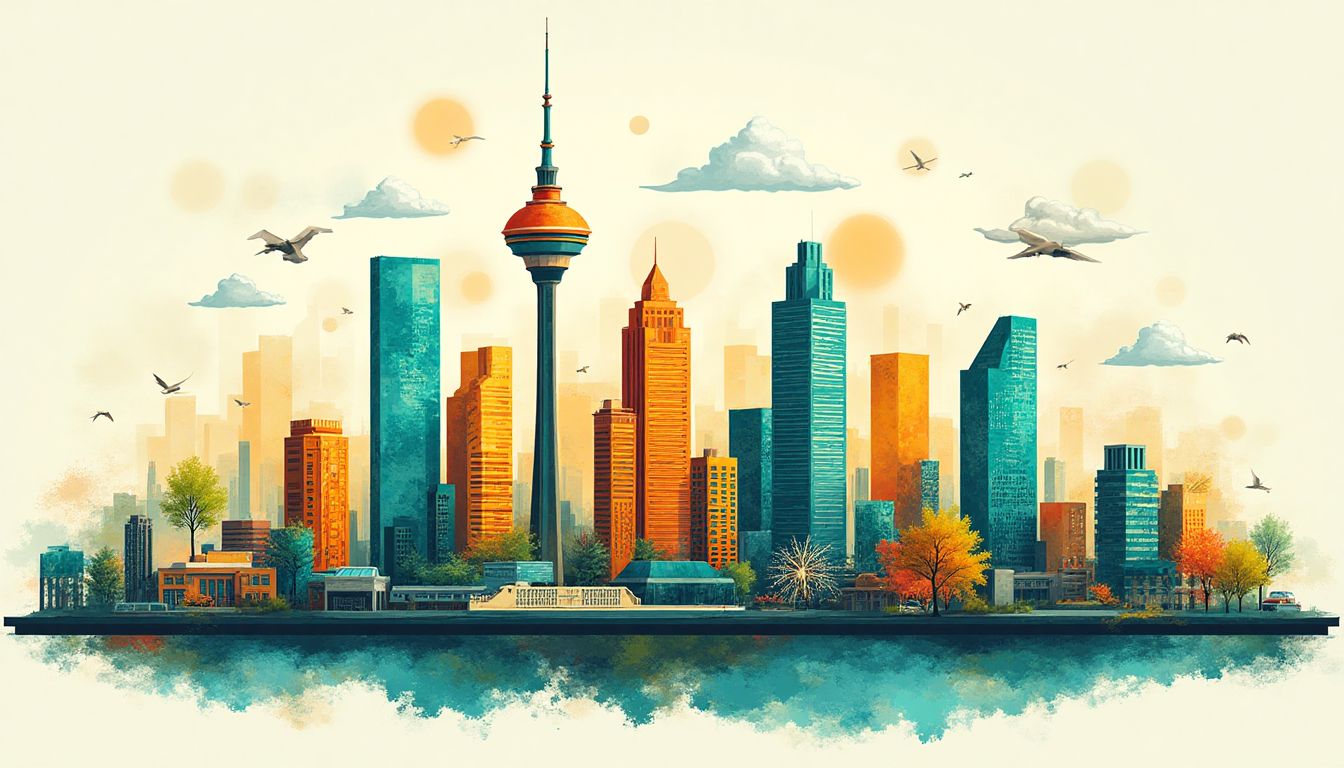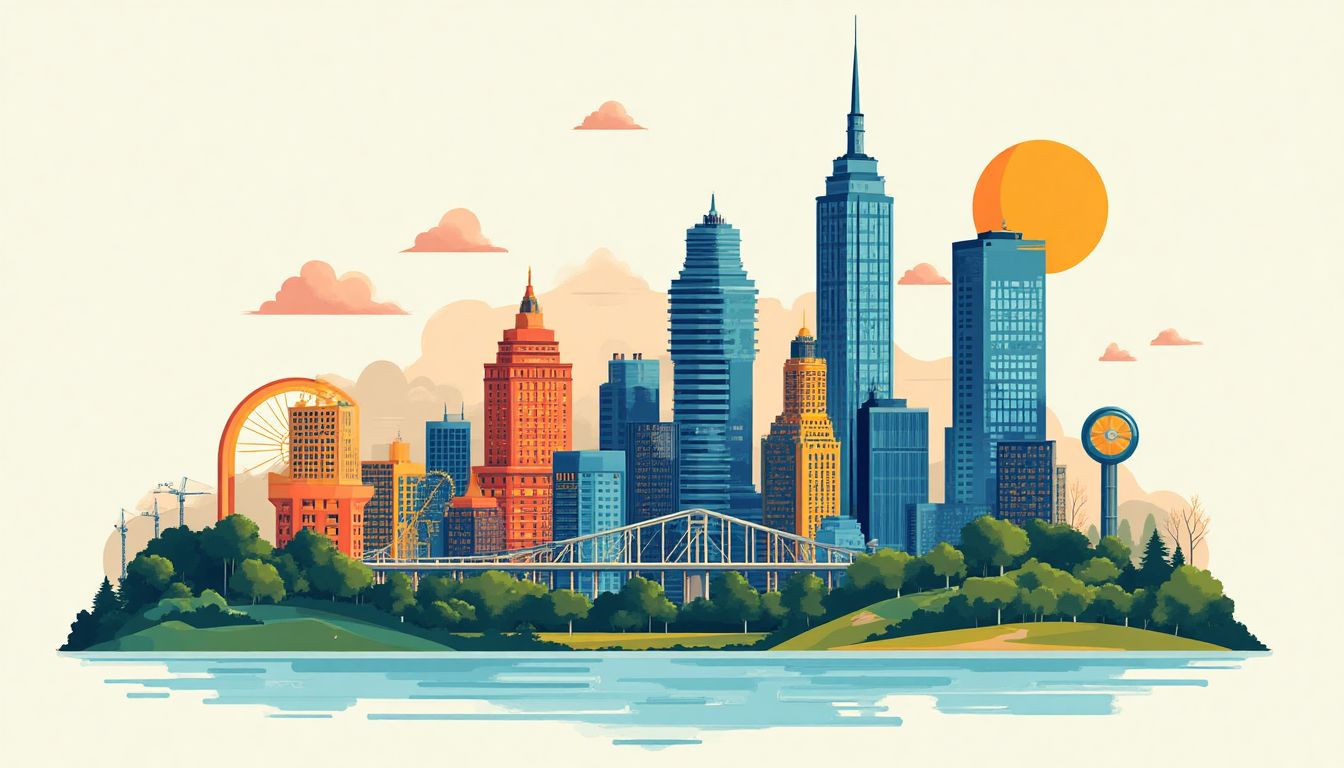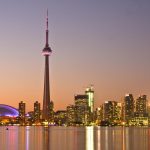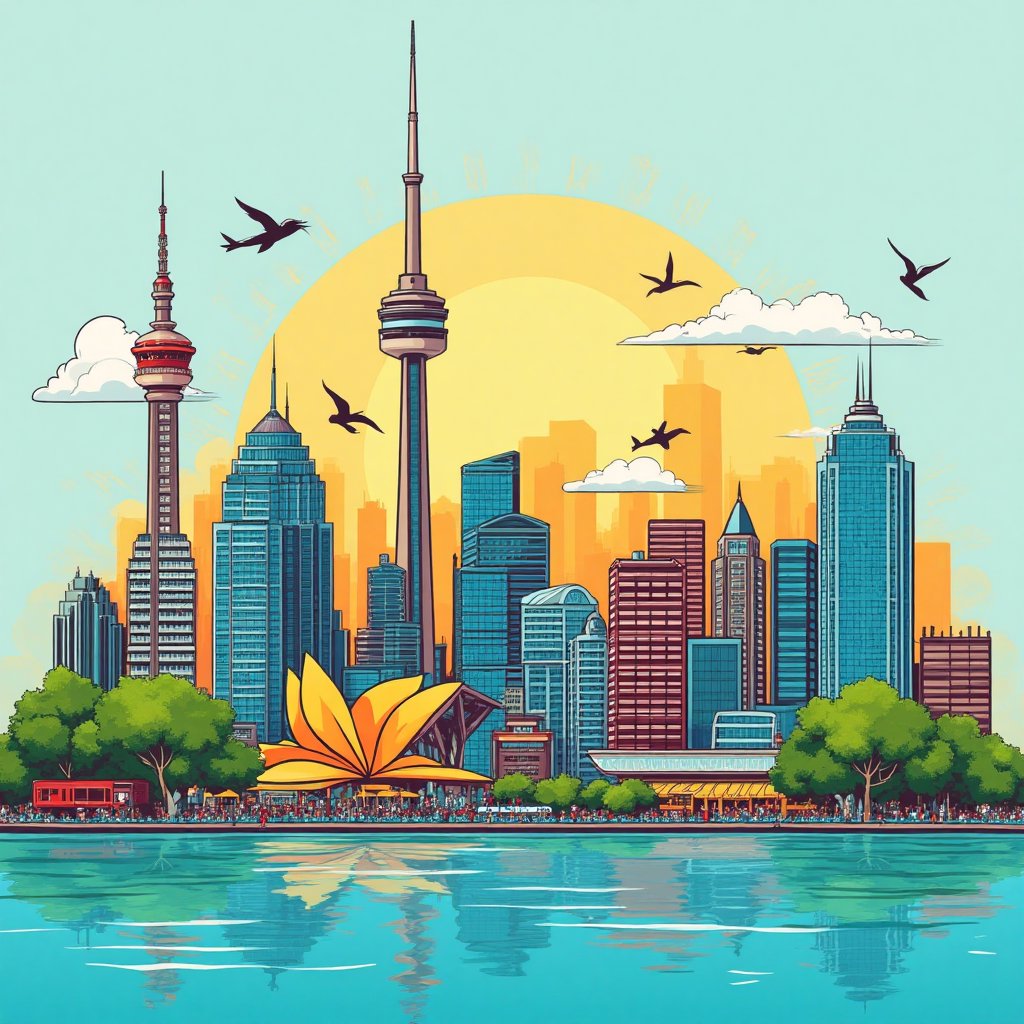Canada, a land of sprawling landscapes and vibrant cities, has always been a tapestry of urban and rural life. But what exactly is the "6th city" in Canada? Is it a hidden gem, a bustling metropolis, or a quiet town with a big story? The answer isn’t as straightforward as you might think. Renowned urbanist Jane Jacobs once said, "Cities have the capability of providing something for everybody, only because, and only when, they are created by everybody." This sentiment rings true as we explore the concept of the "6th city" in Canada, a term that goes beyond mere population rankings to encompass economic, cultural, and environmental significance.
Canadian author Douglas Coupland has often highlighted the unique identities of Canadian cities, from Toronto’s financial hustle to Vancouver’s natural allure. Meanwhile, economist Richard Florida has emphasized the role of cities as hubs of innovation and creativity. Together, these perspectives help us understand why the "6th city" is more than just a number—it’s a reflection of Canada’s evolving urban landscape.
In this article, we’ll unravel the mystery of the "6th city," examining its origins, significance, and what it means for Canada’s future. From the bustling streets of Toronto to the cultural richness of Montreal, and the emerging potential of cities like Halifax and Winnipeg, we’ll explore how each city contributes to the nation’s identity. Along the way, we’ll also consider how artificial intelligence (AI) could revolutionize urban planning, offering innovative solutions to challenges like population growth, housing affordability, and environmental sustainability. So, what is the 6th city in Canada? Let’s find out.
Understanding the "6th City" Concept
Defining the "6th City"
The term "6th city" might sound like a ranking from a high school sports league, but in the context of Canada, it’s a way to categorize urban centers based on their population size. Currently, Edmonton holds the title of the 6th largest city in Canada, with a population of over 1 million people. But as urbanist Jane Jacobs would argue, a city’s significance isn’t just about how many people live there—it’s about how those people shape the city’s identity.
Current Rankings
Canada’s top 10 cities by population include Toronto, Montreal, Vancouver, Calgary, Ottawa, and Edmonton. While Toronto takes the crown as the largest city, Edmonton’s position as the 6th city is a testament to its growth and influence. But let’s not forget, rankings can be fluid. As economist Richard Florida points out, cities are dynamic entities that evolve over time.
Beyond Population: Other Metrics
Population is just one way to measure a city’s importance. Economic output, cultural significance, and quality of life are equally, if not more, important. For example, Halifax might not be in the top 5 by population, but its rich maritime history and vibrant arts scene make it a cultural powerhouse. Similarly, Winnipeg’s affordability and community spirit offer a quality of life that rivals larger cities. As Canadian author Douglas Coupland would say, "Every city has its own rhythm, its own story."
The Role of Cities in Canada’s Identity
Canada’s cities are more than just dots on a map—they’re the beating heart of the nation’s identity. Each city brings its own flavor to the table, whether it’s through economic power, cultural richness, or sheer innovation. Let’s take a closer look at how these urban centers shape Canada’s story.
Economic Powerhouses
When it comes to economic clout, Toronto wears the crown. As Canada’s financial capital, it’s home to the Toronto Stock Exchange, the largest in the country. Think of it as the Wall Street of the North, but with more maple syrup and fewer pinstripe suits. Toronto’s skyline, dotted with skyscrapers, is a testament to its economic might.
Meanwhile, Calgary is the energy kingpin. Known as the hub of Canada’s oil and gas industry, it’s where fortunes are made and lost faster than you can say “pipeline.” Calgary’s Stampede might be its most famous event, but it’s the energy sector that keeps the city’s lights on—literally.
Cultural Hubs
If Toronto is the brain and Calgary the brawn, Montreal is the soul. This bilingual city is a cultural powerhouse, blending French and English influences into a unique tapestry. From the Montreal International Jazz Festival to its world-class museums, Montreal is where art and culture collide in the best way possible.
Then there’s Vancouver, the poster child for natural beauty and multiculturalism. Nestled between the Pacific Ocean and the Coast Mountains, Vancouver is a haven for outdoor enthusiasts. But it’s also a melting pot of cultures, with neighborhoods like Chinatown and Punjabi Market adding to its vibrant diversity.
Emerging Cities
While the big players grab the headlines, smaller cities are quietly making their mark. Take Halifax, for example. This maritime gem is becoming a hub for tech startups and innovation. With its historic charm and forward-thinking mindset, Halifax is proof that you don’t need to be big to be bold.
And let’s not forget Saskatoon, the “Paris of the Prairies.” Known for its thriving arts scene and agricultural roots, Saskatoon is a city on the rise. It’s a reminder that Canada’s urban landscape is as diverse as its people.
Challenges Facing Canada’s Cities
As much as Canada’s cities shine, they’re not without their challenges. From population growth to housing affordability, these urban centers are grappling with issues that could shape their future. Let’s dive into the nitty-gritty.
Population Growth and Urban Sprawl
Canada’s cities are growing faster than a teenager’s appetite. With immigration driving much of this growth, cities like Toronto and Vancouver are feeling the squeeze. Urban sprawl is becoming a real issue, as suburbs stretch further and further out. It’s like trying to fit a size 10 foot into a size 8 shoe—something’s gotta give.
But there’s hope. Cities are turning to smart urban planning and public transit solutions to manage this growth. For example, Toronto’s Metrolinx is expanding its transit network to keep up with demand. It’s a step in the right direction, but there’s still a long road ahead.
Housing Affordability
If you’ve tried to buy a house in Toronto or Vancouver recently, you know the struggle is real. Housing affordability is a crisis, with prices skyrocketing faster than a SpaceX rocket. It’s not just a problem for buyers—renters are feeling the pinch too.
Governments are stepping in with policies to address the issue, like CMHC initiatives to increase affordable housing. But it’s going to take more than a few Band-Aid solutions to fix this. Cities need to think outside the box, whether it’s through innovative housing designs or new zoning laws.
Environmental Sustainability
Climate change is the elephant in the room—or rather, the polar bear on the melting ice cap. Canada’s cities are on the front lines of this battle, with rising temperatures and extreme weather events becoming more common. But they’re also leading the charge in sustainability.
Take Edmonton, for example. The city is investing in green initiatives like waste-to-biofuels facilities to reduce its carbon footprint. And Montreal is turning to renewable energy and public transit to combat climate change. It’s a reminder that even in the face of challenges, Canada’s cities are finding ways to innovate and adapt.
The Future of Canada’s Urban Landscape
As Canada’s cities continue to grow and evolve, the future of urban living is being shaped by technology, regional development, and cultural shifts. From smart cities to innovative regional strategies, the next decade will redefine how Canadians experience urban life. Let’s explore what’s on the horizon.
Smart Cities and Technology
Technology is transforming the way cities operate, making them smarter, more efficient, and more responsive to the needs of their residents. Smart city initiatives are already underway in cities like Toronto and Vancouver, where AI and IoT (Internet of Things) are being used to optimize everything from traffic flow to energy consumption. For example, Toronto’s Sidewalk Labs project aims to create a neighborhood powered by cutting-edge technology, from self-driving shuttles to energy-efficient buildings.
Key technologies driving smart cities include:
- AI-Powered Traffic Management: Reducing congestion and improving public transportation efficiency.
- Smart Grids: Optimizing energy use and integrating renewable energy sources.
- IoT Sensors: Monitoring air quality, waste management, and water usage in real-time.
Regional Development
While major cities like Toronto and Montreal often steal the spotlight, smaller cities and towns are playing an increasingly important role in Canada’s urban landscape. Regional development strategies are essential to ensure balanced growth and economic opportunities across the country. For instance, Halifax is emerging as a hub for tech startups, while Saskatoon is leveraging its agricultural roots to become a leader in agri-tech innovation.
Key strategies for regional development include:
- Infrastructure Investment: Building roads, public transit, and broadband networks to connect rural and urban areas.
- Economic Diversification: Supporting industries like tech, tourism, and renewable energy to reduce reliance on traditional sectors.
- Community Engagement: Involving local residents in decision-making to ensure development meets their needs.
Cultural Evolution
As Canada’s demographics shift, so too does the cultural fabric of its cities. Immigration is bringing new traditions, languages, and perspectives, enriching the cultural landscape. Cities like Montreal and Toronto are known for their multiculturalism, but smaller cities are also embracing diversity. For example, Winnipeg has become a hub for Indigenous art and culture, while Calgary
AI Solutions: How Could AI Help?
Artificial Intelligence (AI) is no longer a futuristic concept—it’s here, and it’s transforming the way we live, work, and plan our cities. For Canada’s urban centers, AI offers a toolkit of solutions to tackle some of the most pressing challenges, from population growth to environmental sustainability. Here’s how AI could revolutionize urban planning and city development in Canada:
Data-Driven Urban Planning
AI can analyze vast amounts of data to predict population growth, infrastructure needs, and resource allocation. For example, Element AI, a Montreal-based company, specializes in using machine learning to optimize urban systems. By leveraging AI, cities like Edmonton and Halifax can create predictive models for housing demand, transportation networks, and public services, ensuring they’re prepared for future growth.
Smart Infrastructure
Imagine a city where traffic lights adjust in real-time to reduce congestion, or where energy grids optimize power usage to minimize waste. AI-powered systems like those developed by Siemens are already making this a reality. In Canada, cities like Toronto and Vancouver could implement AI-driven traffic management and energy-efficient buildings to improve quality of life while reducing environmental impact.
Sustainability and Climate Resilience
Climate change is one of the greatest challenges facing Canadian cities. AI can help by monitoring carbon emissions, predicting extreme weather events, and optimizing resource use. For instance, IBM’s AI for Climate initiative uses predictive analytics to help cities prepare for and mitigate the effects of climate change. Edmonton, with its ambitious Green Initiatives, could use AI to track progress and identify areas for improvement.
Enhancing Quality of Life
AI isn’t just about infrastructure—it’s about people. From personalized healthcare to adaptive learning systems, AI can improve the quality of life for urban residents. For example, DeepMind is using AI to revolutionize healthcare, while Khan Academy leverages AI to provide personalized education. Canadian cities could adopt similar technologies to create smarter, more inclusive communities.
Implementation Challenges
While the potential of AI is immense, it’s not without challenges. Privacy concerns, ethical considerations, and equitable access to technology are critical issues that must be addressed. Collaborations between governments, tech companies, and academic institutions, like the University of Toronto’s AI research programs, can help ensure that AI solutions are implemented responsibly and inclusively.
Action Schedule/Roadmap
Here’s a detailed roadmap for implementing AI solutions in Canada’s cities, inspired by the precision of the Manhattan Project but tailored for today’s technology and challenges:
- Day 1: Assemble a task force of urban planners, AI experts, and policymakers. Key stakeholders include Alberta Innovates, Mitacs, and Element AI.
- Day 2: Conduct a comprehensive data audit of Canada’s cities, focusing on population growth, infrastructure, and environmental impact.
- Week 1: Develop AI models for population and infrastructure analysis, leveraging tools from IBM Watson and Google AI.
- Week 2: Launch pilot projects in Edmonton and Halifax, focusing on AI-powered traffic management and energy optimization.
- Month 1: Evaluate pilot results and refine AI algorithms, incorporating feedback from local communities and stakeholders.
- Month 2: Expand AI initiatives to other cities, including Toronto, Vancouver, and Montreal, with a focus on scalability and adaptability.
- Year 1: Implement AI-powered traffic and energy systems nationwide, using lessons learned from pilot projects.
- Year 1.5: Launch AI-driven sustainability programs, such as carbon emission tracking and disaster preparedness systems.
- Year 2: Establish a national framework for smart city development, ensuring that AI solutions are integrated into urban planning at all levels.
The Future of Canada’s Urban Landscape
The concept of the "6th city" in Canada is more than just a ranking—it’s a reflection of the country’s dynamic urban landscape. From Edmonton’s economic prowess to Halifax’s cultural vibrancy, each city plays a vital role in shaping Canada’s future. By leveraging AI and innovative urban planning strategies, Canada can address challenges like population growth, housing affordability, and environmental sustainability.
AI offers a powerful toolkit for creating smarter, more resilient cities. From data-driven urban planning to smart infrastructure and sustainability initiatives, the possibilities are endless. But the success of these efforts depends on collaboration between governments, tech companies, and communities. The roadmap outlined in this article provides a clear path forward, ensuring that Canada’s cities remain vibrant, inclusive, and forward-thinking.
As we look to the future, one thing is clear: the cities of tomorrow will be shaped by the decisions we make today. By embracing AI and innovative solutions, Canada can lead the way in creating urban environments that are not only efficient and sustainable but also equitable and inspiring. The "6th city" is just the beginning—what will the future hold for Canada’s urban landscape?
FAQ
Q1: What is the "6th city" in Canada?
The "6th city" in Canada refers to the sixth-largest city by population, which is currently Edmonton, Alberta. This ranking is based on population size, but it also considers factors like economic output, cultural influence, and quality of life.
Q2: How are Canadian cities ranked?
Canadian cities are ranked using several criteria, including:
- Population: The number of people living in the city.
- Economic Output: The city's contribution to the national GDP, such as Toronto being Canada's financial hub.
- Cultural Significance: The city's role in arts, history, and multiculturalism, like Montreal’s vibrant arts scene.
- Quality of Life: Factors like healthcare, education, and environmental sustainability, which make cities like Vancouver highly desirable.
Q3: How can AI improve urban planning in Canada?
Artificial Intelligence (AI) can transform urban planning in several ways:
- Data Analysis: AI can analyze population growth and infrastructure needs to help cities plan better.
- Smart Infrastructure: AI-powered systems can manage traffic, energy, and public services more efficiently.
- Sustainability: AI can monitor carbon emissions and predict environmental risks, helping cities like Edmonton become more eco-friendly.
- Quality of Life: AI can improve healthcare, education, and public services, making cities more livable.
Q4: What are the biggest challenges facing Canada’s cities?
Canada’s cities face several challenges, including:
- Population Growth: Rapid urbanization is straining infrastructure in cities like Toronto and Vancouver.
- Housing Affordability: Many Canadians struggle to afford homes in major cities due to rising prices.
- Environmental Sustainability: Cities must address climate change and reduce their carbon footprints.
Q5: What is the future of Canada’s urban landscape?
The future of Canada’s cities will likely involve:
- Smart Cities: Using technology like AI to improve urban living, as seen in initiatives by Element AI.
- Regional Development: Balancing growth between major cities and smaller towns to ensure economic stability.
- Cultural Evolution: Adapting to changing demographics and fostering vibrant arts and cultural scenes.
Q6: What makes Edmonton unique as the 6th city?
Edmonton stands out for its:
- Economic Role: It’s a hub for Canada’s oil and gas industry.
- Cultural Scene: Known for its festivals, like the Edmonton Fringe Festival.
- Future Plans: Edmonton is investing in sustainability and innovation to remain a key player in Canada’s urban landscape.
Q7: How can I learn more about Canada’s cities?
For more information, visit local city portals like Edmonton News or explore resources from organizations like the Canada Council for the Arts and Statistics Canada.
Wait! There's more...check out our gripping short story that continues the journey: The Secrets Within
Disclaimer: This article may contain affiliate links. If you click on these links and make a purchase, we may receive a commission at no additional cost to you. Our recommendations and reviews are always independent and objective, aiming to provide you with the best information and resources.
Get Exclusive Stories, Photos, Art & Offers - Subscribe Today!




























Post Comment
You must be logged in to post a comment.